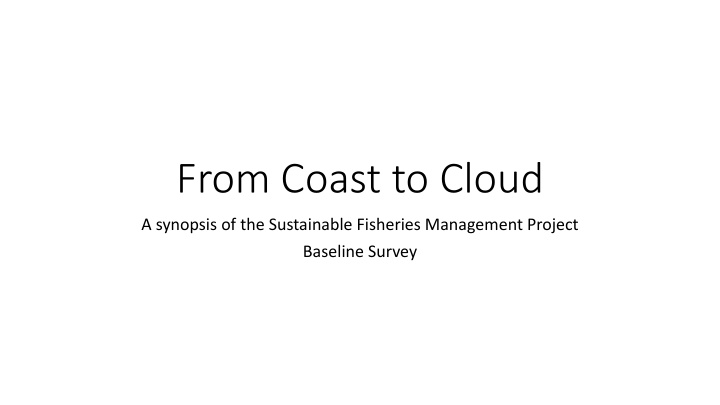



From Coast to Cloud A synopsis of the Sustainable Fisheries Management Project Baseline Survey
Overview of Presentation • Survey Background • SFMP objective and baseline questions of interest • Sample size, communities, and GIS sampling • Paperless Survey Specifics • Software used • Lifecycle of a paperless survey • Training, Logistics, and Supervision • Additional training and considerations • Real-time field supervision aids
Survey Design Team • Core Design Team • Dr. Brian Crawford, SFMP Chief of Party • Hardi Bakari, SFMP Monitoring and Evaluation Officer • Dr. Liliana Gonzalez, URI Statistics Section Head • Daven Amin, URI Statistics Graduate Assistant • Supporting Team Members • Justice Mensah, Hen Mpoano GIS Expert • Yaw Amo Sarpong, Baseline Survey Field Supervisor, KNUST • Najih Lazar, SFMP Senior Fisheries Advisor • Kofi Agbogah, Hen Mpoano Director
Sustainable Fisheries Management Project (SFMP) Objective “The SFMP squarely aims to rebuild targeted fish stocks. Adoption of sustainable fishing practices and reduced exploitation to end overfishing is the only way Ghana can increase its wild-caught local marine food fish supply and bring greater profitability to the fishery, with the potential to benefit over 130,000 people directly and up to two million indirectly.” - SFMP Program Description, 2014 “Fish comprises a third of animal-based food protein consumed in Africa, and in Ghana that number reaches approximately 60%...” - SFMP Issue Brief: Ghana’s Small Pelagic Fishery in Crisis, 2015
Questions of Interest • Baseline information on small pelagic fisheries members • Perceptions of fish abundance • Women empowerment • Participation in decision making • Prevalence of illegal fishing practices • Degree of Compliance • Child labor and trafficking • Dietary diversity and household demographics • Measure impact of interventions by re-administering survey at project mid-point and conclusion
Sampling Methodology • Number of villages: 10 • restricted by finite project resources • Number of household samples: 450 • determined by power analysis and potential attrition • required to detect medium or large effect sizes in perception questions • Samples proportionally distributed • among villages by number of fishermen recorded in 2013 Canoe Frame Survey Source: OpenStreetMap, GeoNames
Sampling Methodology Source: Daven Amin Difficulties of selecting representative samples: No guarantee of village resident lists, house numbers, or street names!
Sampling Methodology Sampling locations created using ArcGIS: Drawn from buffer region 200m • inland from coastline Assumption: representative • majority of target population lives in close proximity to landing sites Sample locations and equivalent • number of “backup” samples loaded into Google Maps on tablets Google Maps requires data • connectivity, so offline Android map application was developed for adverse situations Source: Justice Mensah, Hen Mpoano
Paperless Survey Considerations • Standards Compliance • Questionnaire authored in XLSForm, readable by various software solutions • Offline Data Collection • Enketo Smart Paper stores completed forms until wireless data is available • Open Source Software • KoBoToolbox can be hosted by CRC or any individual/organization with required infrastructure Sources: xlsform.org, enketo.org, kobotoolbox.org
Authoring an XLSForm Variable Question Question Skip Name Type Appearance Logic
Form rendered by Enketo Using “grid” theme • Uses Google Chrome • webrowser Can be filled out on • Android, iOS, PC, etc… Questions with “skip • logic” only appear when relevant answers marked on preceding questions i.e. highest education • completed only displayed if “Has the respondent ever attended school” marked as “yes”
KoBoToolbox Data Aggregation Rows represent respondents Data is exportable as several • Columns named from XLSForm • common file formats, Answers are coded as specified in form • including CSV and XLS Skipped questions are left as blank cells •
Paperless-Specific Logistics and Training Source: Daven Amin
Paperless-Specific Logistics and Training • Additional training time required to educate enumerators • Locating sampling sites to collect responses • Recording sampling site location in survey form • Enketo can record GPS coordinates of device, but this is not equivalent to recording the INTENDED sampling site • Input lag associated with Enketo software (depends on device) • Additional logistics for using tablets in the field • Devices must be charged on a fluctuating power grid • Power banks provided to extend tablet battery life • SIM cards for several providers issued to enumerators to account for varying cell coverage areas
Field Supervision Aids
Field Supervision Aids
Field Supervision Aids
Final Takeaways • Paperless surveys are efficient! • Minimize data entry errors • Catching inconsistencies between enumerators • Optimizing data quality • Use of tablets allow for easier GIS sampling • GPS radios built into modern tablets • Accuracy is acceptable for household surveys • Tablets can record additional metadata • Start time, stop time, and device ID can be logged Thank you!
Thank you!
Recommend
More recommend